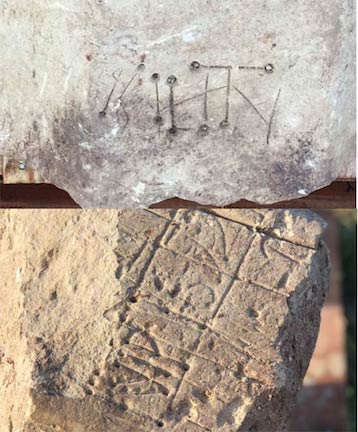
Medieval Graffiti to Repel Witches and Evil Spirits Found In Britain
21 OCTOBER, 2020 - 17:52 ED WHELAN
LINK
In Britain, a mysterious discovery has been made in the ruins of a church in an abandoned medieval village. On some stones, archaeologists have found graffiti and some enigmatic marking. It is believed that the markings were made to ward off evil spirits or witches. This discovery is a timely one as we approach Halloween.
Currently, there is a major infrastructure project being carried out in Stoke Mandeville, Buckinghamshire, England. It involves the construction of rail lines and a highway. This project will totally destroy a long-abandoned medieval village. ‘The deserted village site stands among fields half a mile south of today's Stoke Mandeville’, according to the Buckingham Archaeological Society . Archaeologists from Fusion JV are currently working to excavate as much of the village as they can.
Deserted medieval village
The focus of their work is on the ruins of the 12 th-century church of St Mary’s now little more than rubble. This was demolished many centuries ago, however, archaeologists were stunned to find beneath a heap of stones, the walls and floors of the place of worship. Andrew Harris, a manager with Fusion JV stated that ‘The levels of preservation of some of the features of the church are surprising given its age’ reports the HS2 Media Centre .
On the stones, of the demolished church they have found some graffiti. They have also discovered some curious markings. According to The Bucks Herald , ‘Two stones with a central drilled hole from which a series of lines radiate in a circle have been uncovered at the site of St Mary’s’. These engravings were of great interest to the team of archaeologists.
Witches marks or medieval graffiti?
One possibility was that the markings are medieval sundials that were used to tell the time and indicate the time for mass and prayers to the faithful. However, the engravings were found on a stone that was close to the ground. This would seem to indicate that they were not sundials.
The most likely explanation for the markings on the church is that they are ‘ witches’ marks’ . These are ritual protection symbols and they have been found on a range of medieval buildings from barns to churches. The pattern of the marks was meant to ‘ward off evil spirits by entrapping them in an endless line or maze’ reports The Bucks Herald .
Warding off evil spirits
In the medieval worldview, there were many dangers, not only physical but also from supernatural forces. People genuinely believed that they were in constant danger from evil spirits and witches. In Medieval England, belief in witches and the power of magic was almost universal .
The witches’ markings were part of a practice known as apotropaic magic , which seeks to deflect away curses and misfortune. These markings were made to protect the church and its worshippers. The origin of the practice may lie in pagan times, and survived into Christian times, which was not uncommon.
Recovering village’s history
The medieval graffiti is the latest discovery made at St Mary’s. It was built as a private chapel for the lord of the local manor and his family. In the 14 th century, the church was extended, and it was used by the local villagers. The population of the village in the Middle Ages was about 800. St Mary’s was the center of the village and around it ‘were buildings, mill races and fishponds... perhaps a moat’ reports the Buckinghamshire Archaeological Society .
Work is continuing at the site of the church and other locations in the deserted village. Mr Harris told HS2 Media Centre that ‘we look forward to continuing this work and being able to share our discoveries with the local communities.’ Archaeologists believe that the remains of an Anglo-Saxon church may be found beneath the 11 th-century chapel. The HS2 project is shortly going to participate in a webinar, where the finds at the deserted village will be shared with young people who are interested in archaeology.
